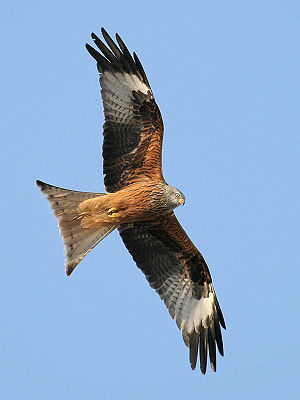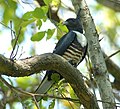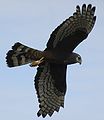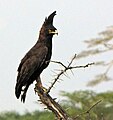Hawks
| Hawks | ||||||||||||
|---|---|---|---|---|---|---|---|---|---|---|---|---|

Red kite ( Milvus milvus ) |
||||||||||||
| Systematics | ||||||||||||
|
||||||||||||
| Scientific name | ||||||||||||
| Accipitridae | ||||||||||||
| Vieillot , 1816 |
The hawk-like (Accipitridae; from Latin accipiter , 'Schnellflieger, Habicht' ) are a family of birds of prey and include most of their representatives, depending on the author about 76-82 genera and 260 living species . The hawk-like family includes, for example, most of the birds known as eagles and vultures , as well as the buzzards , harriers , hawks and sparrowhawks .
The hawk-like species are found almost worldwide, with the exception of Antarctica and numerous oceanic islands. Every large ecosystem on earth is inhabited by them, only in very dry deserts and in the northernmost arctic tundra they are absent. The greatest biodiversity is found in tropical regions.
features
The hawk-like have broad wings and high beaks. The wingspan is between 50 cm and 3 m depending on the species. The body length ranges from 25 cm to 1.5 m. Their weight is between 80 g and 12.5 kg. The base of the upper beak is covered by a waxy skin that is often brightly colored. The eyes are large and in most species are located under a bony clasp on the skull.
Forest dwellers generally have short wings and long tails for maneuverability. In contrast, residents of open landscapes have long wings. In large species that fly very high in search of prey and sail long distances, the outer feathers of the wings are often finger-like apart to avoid turbulence. The tails can be rounded, wedge-shaped or forked.
Hawks are usually brown, black, or gray in color as they adapt to their environment. Often a striped pattern appears in the plumage. The undersides are often light. With some species there are lighter and darker colored morphs or different colorations in geographically distant populations. In most species, the females are larger than the males, most pronounced in the fast, bird-catching hawks and sparrows. Other species show a sexual dimorphism in color. Here the male is usually more conspicuously colored and the female retains a plumage similar to that of the young birds. An example here are ordinations .
In the first year of life, the plumage of birds is often very different from that of adults and is mostly brown with a lighter upper and a darker underside. Young birds of different species often look alike. The change from the plumage of young birds to the plumage of adults takes place in most species after the first year of life. For most eagles, the change takes several years. Hawks molt once a year.
Hawk species differ from the hawks in their yellow, red or nut-colored eyes, those of the hawks are brownish, their nesting (hawks take over the abandoned nests of other birds), some features in the skeleton and by the powerful expulsion of their excretions.
nutrition
Most of the hawk species are exclusively carnivorous , predominantly as opportunistic hunters, preying on what is seen and is easy to catch. Often this is also supplemented by carrion. The food spectrum of the different species includes small and medium-sized mammals, birds (including nestlings and eggs), reptiles (including snakes), amphibians, fish and many invertebrates. Buzzards mainly prey on small mammals, hawks and sparrowhawks, especially birds. Some species have specialized their diet to a large extent and this is sometimes also shown in the species names, such as short- toed eagle , honey buzzard , bat hair or snail harrier . Vultures almost exclusively eat carrion, some species also eat excrement. However, some hawks also eat fruit - the palm vulture feeds primarily on the fruits of various palm trees.
Reproduction
Most hawks are monogamous throughout the year , some for life. In all hawk-like species, the male and female build the nest, the male carrying the nesting material and the female taking on the actual nest building. The female lays an egg every two to five days and usually begins hatching with the first or the second. In most species, both males and females breed. The breeding period is 28 to 60 days, larger species usually breed longer. Because brood begins before all eggs are laid, the young hatch at different times and the older chicks are larger than those that have just hatched.
Systematics
Traditional systematics
Subfamily hawks and sparrowhawks (Accipitrinae)
-
Hawks and sparrowhawks ( Accipiter ) - 52 species
- Magpie goshawk ( Accipiter albogularis )
- Shikrasperber ( Accipiter badius )
- Bicolor sparrow ( Accipiter bicolor )
- Dreifarbensperber ( Accipiter brachyurus )
- Kurzfangsperber ( Accipiter brevipes )
- Nicobar sparrow ( Accipiter butleri )
- Red- flanked goshawk ( Accipiter castanilius )
- Chiles Boar ( Accipiter chilensis )
- White-breasted sparrow ( Accipiter chionogaster )
- Sydney's spider ( Accipiter cirrocephalus )
- Collared Cattle ( Accipiter collaris )
- 'S Hawk ( Accipiter cooperii )
- Accipiter efficax †
- Red-necked sparrow ( Accipiter erythrauchen )
- Redshank cattle ( Accipiter erythronemius )
- Wood sparrow ( Accipiter erythropus )
- Banded goshawk ( Accipiter fasciatus )
- Lizard Hawk ( Accipiter francesiae )
- Goshawk ( Accipiter gentilis )
- Gray-headed goshawk ( Accipiter griseiceps )
- Trillersperber ( Accipiter gularis )
- Gundlachsperber ( Accipiter gundlachi )
- White-bellied goshawk ( Accipiter haplochrous )
- Halmaherahabicht ( Accipiter henicogrammus )
- Madagascar goshawk ( Accipiter henstii )
- Trughabicht ( Accipiter imitator )
- Rabble hawk ( Accipiter luteoschistaceus )
- Madagascar sparrow ( Accipiter madagascariensis )
- Black- mantled goshawk ( Accipiter melanochlamys )
- Goshawk ( Accipiter melanoleucus )
- Meyer goshawk ( Accipiter meyerianus )
- Dwarf Sperber ( Accipiter minullus )
- Archboldsperber ( Accipiter nanus )
- Sparrowhawk ( Accipiter nisus )
- White- browed goshawk ( Accipiter novaehollandiae )
- Ovambosperber ( Accipiter ovampensis )
- Ash-headed goshawk ( Accipiter poliocephalus )
- Gray abdominal Habicht ( Accipiter polio gaster )
- Prince hawk ( Accipiter princeps )
- Accipiter quartus †
- Schlegel's cattle ( Accipiter rhodogaster )
- Fiji hawk ( Accipiter rufitorques )
- Red-bellied sparrow ( Accipiter rufiventris )
- Frog sparrow ( Accipiter soloensis )
- Eckschwanzsperber ( Accipiter striatus )
- Thumbnail sparrow ( Accipiter superciliosus )
- Afrikahabicht ( Accipiter tachiro )
- Red-breasted goshawk ( Accipiter toussenelii )
- Spot tail Sperber ( Accipiter trinotatus )
- Crested goshawk ( Accipiter trivirgatus )
- Andean sparrow ( Accipiter ventralis )
- Besrasperber ( Accipiter virgatus )
-
Fox shawls ( Erythrotriorchis ) - 2 species
- Prachthabicht ( Erythrotriorchis buergersi )
- Fox shawl ( Erythrotriorchis radiatus )
-
Heterospice
- Frog hawk ( Heterospizias meridionalis )
-
Megatriorchis
- Salvadoran goshawk ( Megatriorchis doriae )
-
Micronisus
- Gabar goshawk ( Micronisus gabar )
-
Urotriorchis
- Long-tailed goshawk ( Urotriorchis macrourus )
Subfamily Old World Vulture (Aegypiinae)
-
Aegypius
- Mönchsgeier ( Aegypius monachus )
-
Gyps - 9 types
- White-backed vulture ( Gyps africanus )
- Bengal vulture ( Gyps bengalensis )
- Cape vulture ( Gyps coprotheres )
- Griffon Vulture ( Gyps fulvus )
- Snow Vulture ( Gyps himalayensis )
- Indian vulture ( Gyps indicus )
- Gyps melitensis †
- Sparrow eggs ( Gyps rueppellii )
- Thin-billed vulture ( Gyps tenuirostris )
-
Necrosyrtes
- Cap vulture ( Necrosyrtes monachus )
- Neogyps †
-
Torgos
- Lappet vulture ( Torgos tracheliotus )
-
Trigonoceps
- Woolly vulture ( Trigonoceps occipitalis )
Subfamily Aquilinae
-
Real eagles ( Aquila ) - 13 species
- Spanish Imperial Eagle ( Aquila adalberti )
- Black-axed eagle ( A. africanus )
- Wedge-tailed eagle ( Aquila audax )
- Golden eagle ( Aquila chrysaetos )
- Greater spotted eagle ( Aquila clanga )
- Ganges eagle ( Aquila hastata )
- Eastern imperial eagle ( Aquila heliaca )
- Steppe eagle ( Aquila nipalensis )
- Aquila nipaloides †
- Lesser Spotted Eagle ( Aquila pomarina )
- Predatory eagle ( Aquila rapax )
- Aquila simurgh †
- Coffee eagle ( Aquila verreauxii )
-
Harpagornis †
- Haastadler ( Harpagornis moorei ) †
-
Bonelli's eagle ( Hieraaetus ) - 8 species
- Spotted eagle ( Hieraaetus ayresii )
- Bonelli's eagle ( Hieraaetus fasciatus )
- Red-bellied eagle ( Hieraaetus kienerii )
- Rabbit eagle ( Hieraaetus morphnoides )
- Booted eagle ( Hieraaetus pennatus )
- African Bonelli's eagle ( Hieraaetus spilogaster )
- Silver eagle ( Hieraaetus wahlbergi )
- New Guinea Bonelli's Eagle ( Hieraaetus weiskei )
-
Ictinaetus
- Malay Eagle ( Ictinaetus malayensis )
-
Lophaetus
- Crested eagle ( Lophaetus occipitalis )
- "Old World Crested Eagle" ( Nisaetus ) - 11 species
- Black Eagle ( N. alboniger )
- Andaman crested eagle ( N. andamanensis )
- Java hooded eagle ( N. bartelsi )
- Crested eagle ( N. cirrhatus )
- Flores' crested eagle ( N. floris )
- Nisaetus kelaarti
- Celebes eagle ( N. lanceolatus )
- Crested eagle ( N. nanus )
- Nepal crested eagle ( N. nipalensis )
- Philippine crested eagle ( N. philippensis )
- Mindanao boned eagle ( N. pinskeri )
-
Polemaetus
- Martial eagle ( Polemaetus bellicosus )
- "New World Crested Eagle" ( Spizaetus ) - 6 species
- Spizaetus grinnelli †
- Isido eagle ( S. isidori )
- Spizaetus melanoleucus
- Magnificent hooded eagle ( S. ornatus )
- Spizaetus pliogryps †
- Bonnet eagle ( S. tyrannus )
-
Spizastur
- Elster Adler ( Spizastur melanoleucus )
-
Stephanoaetus - 2 species
- Crowned eagle ( Stephanoaetus coronatus )
- Madagascar crowned eagle ( Stephanoaetus mahery) †
- Titanohierax †
Subfamily Buzzard (Buteoninae)
- Amplibuteo † - 3 types
-
Busarellus
- Buzzard ( Busarellus nigricollis )
-
Locust buzzards ( Butastur ) - 4 species
- Pine tea ( Butastur indicus )
- Malaienteasa ( Butastur liventer )
- Locust Buzzard (
- White eye tea ( Butastur teesa )
-
Buzzards ( buteo ) - 29 species
- White tailed buzzard ( Buteo albicaudatus )
- European white-throated buzzard ( Buteo albigula )
- Ribbon-tailed buzzard ( Buteo albonotatus )
- Archer buzzard ( Buteo archeri )
- Augur Buzzard ( Buteo augur )
- Common buzzard ( Buteo buteo )
- Madagascar buzzard ( Buteo brachypterus )
- Short-tailed buzzard ( Buteo brachyurus )
- Galapagos buzzard ( Buteo galapagoensis )
- Highland buzzard ( Buteo hemilasius )
- Red-tailed buzzard ( Buteo jamaicensis )
- Buzzard ( Buteo lagopus )
- White-winged Buzzard ( Buteo leucorrhous )
- Red-shouldered buzzard ( Buteo lineatus )
- Common buzzard ( Buteo magnirostris )
- Gray buzzard ( Buteo nitidus )
- Mountain Buzzard ( Buteo oreophilus )
- Broad-winged buzzard ( Buteo platypterus )
- Mutable buzzard ( Buteo poecilochrous )
- King Buzzard ( Buteo regalis )
- Haiti Buzzard ( Buteo ridgwayi )
- Himalayan buzzard ( Buteo refectus )
- Eagle Buzzard ( Buteo rufinus )
- Schakal Bussard ( Buteo rufofuscus )
- Socotra buzzard ( Buteo socotraensis )
- Hawaiian buzzard ( Buteo solitarius )
- Common buzzard ( Buteo swainsoni )
- Andean buzzard ( Buteo ventralis )
-
Black buzzards ( Buteogallus ) - 9 species
- Red-bellied buzzard (
- Crab Buzzard ( Buteogallus anthracinus )
- Buteogallus daggetti †
- Savannah Buzzard ( Buteogallus meridionalis )
- Mangrove Buzzard ( Buteogallus subtilis )
- Black Buzzard ( Buteogallus urubitinga )
- Buteogallus fragilis
- Buteogallus borrasi †
- Buteogallus gundlachii
-
Geranoaetus
- Blue buzzard ( Geranoaetus melanoleucus )
- Red-backed buzzard ( Geranoaetus polyosoma )
- Gigantohierax †
-
Hermit eagle ( Harpyhaliaetus ) - 2 species
- Sand eagle ( Harpyhaliaetus coronatus )
- Hermit Eagle (
-
Schwebeweihe ( Ictinia ) - 2 species
- Mississippi Weih ( Ictinia mississippiensis )
- Plumbeous Kite ( Ictinia plumbea )
-
Kaupifalco
- Hawk Buzzard ( Kaupifalco monogrammicus )
-
White buzzards ( Leucopternis ) - 10 species
- Snow buzzard ( Leucopternis albicollis )
- White brewing Bussard ( Leucopternis kuhli )
- White-necked Buzzard ( Leucopternis lacernulatus )
- Chinstrap Buzzard ( Leucopternis melanops )
- Gray-backed Buzzard ( Leucopternis occidentalis )
- Lead buzzard ( Leucopternis plumbeus )
- Mantled Buzzard ( Leucopternis polionotus )
- Prince's Buzzard ( Leucopternis princeps )
- Slate Bussard ( Leucopternis schistaceus )
- Gull Buzzard ( Leucopternis semiplumbeus )
-
Parabuteo
- Desert Buzzard ( Parabuteo unicinctus )
-
Rostrhamus
- Snail Harrier ( Rostrhamus sociabilis )
Subfamily short-toed eagles (Circaetinae)
-
Schlangenadler ( Circaetus ) - 6 types
- Beaudouin short- toed eagle ( Circaetus beaudouini )
- Ribbon snake eagle ( Circaetus cinerascens )
- Monochrome short- toed eagle ( Circaetus cinereus )
- Gray-breasted short- toed eagle ( Circaetus fasciolatus )
- Schlangenadler ( Circaetus gallicus )
- Black-breasted short-toed eagle ( Circaetus pectoralis )
-
Dryotriorchis
- Snake Bussard ( Dryotriorchis spectabilis )
- Philippines eagle ( Pithecophaga )
- Philippines eagle (
-
Snake harriers ( Spilornis ) - 13 species
- Simeulu consecration ( Spilornis abbotti )
- Nias snake harrier ( Spilornis asturinus )
- Baweanschlangenweihe ( Spilornis baweanus )
- Serpent harrier (
- Andaman serpent harrier ( Spilornis elgini )
- Philippine serpent harrier ( Spilornis holospilus )
- Mountain snake harrier ( Spilornis kinabaluensis )
- Kloss snake harrier ( Spilornis klossi )
- Nicobar harrier ( Spilornis minimus )
- Natuna snake harrier ( Spilornis natunensis )
- Riukius serpent harrier ( Spilornis perplexus )
- Celebes consecration ( Spilornis rufipectus )
- Mentawa snake harrier ( Spilornis sipora )
-
Terathopius
- Juggler ( Terathopius ecaudatus )
Subfamily Weihen (Circinae)
-
Consecrations ( Circus ) - 18 types
- Marsh harrier ( Circus aeruginosus )
- Marsh harrier ( Circus approximans )
- Spot consecration ( Circus assimilis )
- White- browed harrier ( Circus buffoni )
- Gray harrier ( Circus cinereus )
- Hen harrier ( Circus cyaneus )
- Forest harrier ( Circus dossenus ) †
- Eyles consecration ( Circus teauteensis ) †
- Hudson consecration ( Circus hudsonius )
- Madagascar Consecration ( Circus macrosceles )
- Steppe harrier ( Circus macrourus )
- Reunion consecration ( Circus maillardi )
- Black Harrier ( Circus maurus )
- Magpie Consecration ( Circus melanoleucus )
- Montagu's Harrier ( Circus pygargus )
- Frog harrier ( Circus ranivorus )
- Mangrove antlers ( Circus spilonotus )
- Papuan Harrier ( Circus spilothorax )
-
Geranospitsa
- Sperber ordination ( Geranospiza caerulescens )
-
Cave harriers ( Polyboroides ) - 2 species
- Madagascar Harrier ( Polyboroides radiatus )
- Harrier ( Polyboroides typus )
Subfamily sliding hairs (Elaninae)
-
Chelictinia
- Swallowtail hair ( Chelictinia riocourii )
-
Gliding pairs ( Elanus ) - 4 species
- Australian gliding hair ( Elanus axillaris )
- Gliding Hair ( Elanus caeruleus )
- White-tailed hair ( Elanus leucurus )
- Black- axed pair ( Elanus scriptus )
-
Gampsonyx
- Perlaar ( Gampsonyx swainsonii )
-
Macheirhamphus
- Bat male ( Macheirhamphus alcinus )
Subfamily Gypaetinae
-
Eutriorchis
- Snake goshawk ( Eutriorchis astur )
-
Gypaetus
- Bearded Vulture ( Gypaetus barbatus )
-
Gypohierax
- Palm vulture ( Gypohierax angolensis )
-
Neophrone
- Egyptian vulture ( Neophron percnopterus )
- Neophron tops †
Subfamily Haliaeetinae
-
White-tailed eagles ( Haliaeetus ) - 8 species
- White-tailed eagle ( Haliaeetus albicilla )
- Bald eagle ( Haliaeetus leucocephalus )
- White-bellied sea eagle ( Haliaeetus leucogaster )
- Sea eagle ( Haliaeetus leucoryphus )
- Giant sea eagle ( Haliaeetus pelagicus )
- Solomon Sea Eagle ( Haliaeetus sanfordi )
- Fish eagle ( Haliaeetus vocifer )
- Madagascar sea eagle ( Haliaeetus vociferoides )
-
Fish eagle ( Ichthyophaga ) - 2 species
- Brown- tailed sea eagle ( Ichthyophaga humilis )
- Gray head eagle ( Ichthyophaga ichthyaetus )
Subfamily Harpiinae
-
Harpia
- Harpy eagle ( Harpia harpyja )
-
Harpyopsis
- Papua eagle ( Harpyopsis novaeguineae )
-
Morphnus
- Kangaroo eagle ( Morphnus guianensis )
Subfamily singing hawk (Melieraxinae)
-
Song hawk ( Melierax ) - 3 species
- Great song hawk ( Melierax canorus )
- Graubürzel song hawk ( Melierax metabates )
- White- rumped song hawk ( Melierax poliopterus )
Subfamily kites (Milvinae)
-
Haliastur - 2 types
- Brahmin consecration ( Haliastur indus )
- Wedge-tailed harrier ( Haliastur sphenurus )
-
Harpagus - 2 species
- Double tooth harp ( Harpagus bidentatus )
- Braunschenkelweih ( Harpagus diodon )
-
Helicolestes
- Hook harrier ( helicolestes hamatus )
-
Kites ( Milvus ) - 3 types
- Milvus aegyptius
- Black kite ( Milvus migrans )
- Red kite ( Milvus milvus )
Subfamily Honey Buzzards (Perninae)
-
Crested Buzzards ( Aviceda ) - 5 species
- Cuckoo Fair ( Aviceda cuculoides )
- Hindu Weih ( Aviceda jerdoni )
- Lemur Weih ( Aviceda madagascariensis )
- Dreificolorweih ( Aviceda leuphotes )
- Papua Weih ( Aviceda subcristata )
-
Long-billed harrier ( Chondrohierax ) - 2 species
- Long-billed harrier ( Chondrohierax uncinatus )
- Kuba-Langschnabelweih ( Chondrohierax wilsonii )
- Swallow Harrier ( Elanoides )
- Schwalbenweih ( Elanoides forficatus )
-
Hamirostra
- Black-breasted kite ( Hamirostra melanosternon )
-
Honey buzzards ( Henicopernis ) - 2 species
- Bismarck Weih ( Henicopernis infuscatus )
- Long-tailed Weih ( Henicopernis longicauda )
-
Lophoictinia
- Crested kite ( Lophoictinia isura )
-
Honey buzzards ( Pernis ) - 5 species
- Honey buzzard ( Pernis apivorus )
- Celebes honey buzzard ( Pernis celebensis )
- European honey buzzard ( Pernis orientalis )
- Crested wasp buzzard ( Pernis ptilorhynchus )
- Philippine Wasp Buzzard ( Pernis steerei )
Phylogenetic systematics
The investigation of the relationships of the Accipitridae with molecular genetic methods is still the subject of ongoing research. The following cladogram shows the family relationships of the subfamilies according to Lerner and Mindell (2005).
| Accipitridae |
|
||||||||||||||||||||||||||||||||||||||||||||||||||||||||||||||||||||||||||||||
|
|
Shikra ( Accipiter badius )
Eastern imperial eagle ( Aquila heliaca )
Dreificolorweih ( Aviceda leuphotes )
Red-tailed buzzard ( Buteo jamaicensis )
Schlangenadler (Circaetus gallicus)
White- browed harrier ( Circus buffoni )
Gliding Hair ( Elanus caeruleus )
Blue buzzard ( Geranoaetus melanoleucus )
White-bellied sea eagle ( Haliaeetus leucogaster )
Fish eagle ( Haliaeetus vocifer )
Harpy eagle ( Harpia harpyja )
Booted eagle ( Hieraetus pennatus )
Crested eagle ( Lophaetus occipitalis )
Great song hawk ( Melierax canorus )
Cap vulture ( Necrosyrtes monachus )
Serpent harrier ( Spilornis cheela )
Juggler ( Terathopius ecaudatus )
Lappet vulture ( Torgos tracheliotus )
literature
- Ferguson-Lees & Christie: The world's birds of prey . Translated by Volker Dierschke and Jochen Dierschke. Franckh-Kosmos, Stuttgart 2009, ISBN 978-3-440-11509-1 .
- J. Ferguson-Lees, DA Christie: Raptors of the World. Christopher Helm, London 2001, ISBN 0-7136-8026-1 .
- HRL Lerner, DP Mindell: Phylogeny of eagles, Old World vultures and other Accipitridae based on nuclear and mitochondrial DNA . Molecular Phylogenetics and Evolution 37; 2005: pp. 327-346. PDF
- M. Wink, H. Sauer-Gürth: Phylogenetic Relationships in Diurnal Raptors based on nucleotide sequences of mitochondrial and nuclear marker genes . In: RD Chancellor and B.-U. Meyburg (eds): Raptors Worldwide . Berlin, Budapest 2004: pp. 483–498. PDF
- Kirschbaum, K. 2004. " Accipitridae ", Animal Diversity Web. Accessed January 4, 2010.
Web links
Individual evidence
- ^ Karl Ernst Georges : Comprehensive Latin-German concise dictionary . 8th, improved and increased edition. Hahnsche Buchhandlung, Hannover 1918 ( zeno.org [accessed on August 29, 2018]).
- ↑ Ferguson-Lees, Christie: The birds of prey of the world (German by Volker Dierschke and Jochen Dierschke). Franckh-Kosmos-Verlags-GmbH & Co. KG, Stuttgart, 2009, ISBN 978-3-440-11509-1
- ↑ Heather RL Lerner, David P. Mindell: Phylogeny of eagles, Old World vultures, and other Accipitridae based on nuclear and mitochondrial DNA Molecular Phylogenetics and Evolution Vol. 37 (2005), pp. 327-346, doi: 10.1016 / j. ympev.2005.04.010 , PDF

















